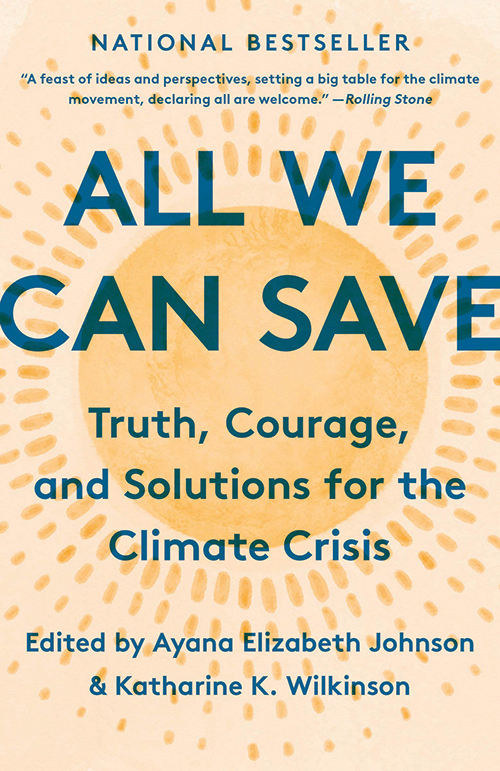
All We Can Save: Truth, Courage, and Solutions for the Climate Crisis
Reviewed by Pamela Haines
January 1, 2022
Edited by Ayana Elizabeth Johnson and Katharine K. Wilkinson. One World, 2020. 448 pages. $29/hardcover; $18/paperback; $13.99/eBook.
This collection of essays from women at the forefront of the climate movement unfolds in eight parts. Throughout the first five sections—Root, Advocate, Reframe, Reshape, Persist—my dominant response was gratitude for the opportunity to be bathed in the wisdom, generosity, and courage of all these good women.
Though I have read widely on this topic, I kept coming across new treasures. A Latina artist talks about how White male domination has narrowed our collective gaze. She suggests that “just as ecosystems need biodiversity to thrive, society needs cultural diversity to grow new possibilities. Monoculture deadens our collective potential.” Later, an energy policy expert speaks of her lifetime goal to prevent more carbon emissions than she causes. Her carbon offset plan, she says, is activism.
The “Feel” section offers a strong reminder of the importance of women’s experience in responding to the climate emergency. Logic and facts are not enough. We need to acknowledge our fears, face our losses, and hold each other with compassion as we find our way forward into the unknown. A poet and activist speaks of the astonishingly beautiful gift that we have been granted: the chance to shepherd life into the future. She names this as a power and privilege that should both humble and motivate us.
The emphasis in the “Nourish” section on restoring the capacities of our soil and water cycles also seemed fitting for an anthology of women’s voices. Solutions here are framed not in the realm of technology but in the incredible powers of sun, plants, earth, and water to work together to support life, and in our ability to value, understand, and nurture the relationships among them. This understanding, integral to our feminine side but suppressed for centuries, needs to be leading the way.
I was grateful for the focus in the final “Rise” section on justice, including attention to climate migrants, who had somehow hovered at the edges of my vision. I resonated with the forthright declaration from a South Louisiana native and one of the organizers behind Gulf South for a Green New Deal that climate change is not the problem but rather a symptom of an economic system that has been built “to extract every precious ounce of value out of this planet and its people” for the benefit of a few. I loved the epiphany of a Puerto Rican woman who was part of picking up the pieces after Hurricane Maria:
When everything collapses—no ATMs, no water, no food, no diesel, no communication . . . the person right in front of you is your best chance at survival. . . . The times we will be facing are going to require us to recognize that the most important thing around us is community.
Overall, I appreciated the thought and care that went into the creation of this book, starting with the range of voices that the editors have gathered—from Indigenous women sharing the wisdom of their ancestors to young women speaking for their generation, from scientists, governmental leaders, and journalists to mothers and community activists from all backgrounds across the country. That thoughtfulness could also be seen in the layout of the book, not just the overall organization but the beautiful illustrations for each section; the unobtrusive highlighting of key ideas, names, and facts throughout; and the fresh and well-designed compilation of resources in the back.
I came to the end with a new appreciation for the title, All We Can Save. As we face the climate emergency, we could easily succumb to despair. Or we could put all our hopes in a comprehensive scientific solution and believe that anything less is a failure. Yet the nurturer in us leads with her heart, and gathers others around to save what we can.
I am exceptionally grateful for this book and would recommend it to everyone who is alive and hopes for a future. There’s no way I can improve on the closing words of the editors:
[W]e were made for this moment. What we do now is dream . . . and every day do something to reel the dream closer to reality. . . .
If there is one theme that runs through the collection, it is ferocious love—for one another, for Earth, for all beings, for justice, for a life-giving future. . . . It is a magnificent thing to be alive in a moment that matters so much.
Pamela Haines is a member of Central Philadelphia (Pa.) Meeting. She is the author of Money and Soul, an expansion of a Pendle Hill pamphlet by the same name. Her newest titles are That Clear and Certain Sound and a volume of poetry, Alive in This World.


